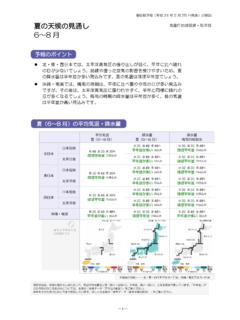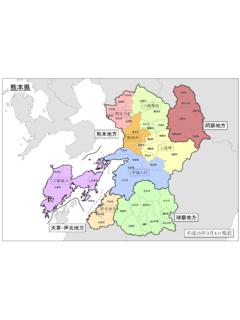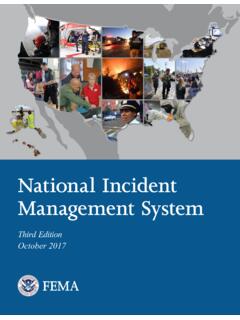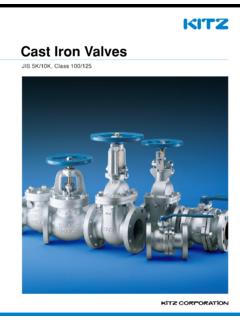Transcription of Chapter 2 Measurement of Temperature
1 Chapter 2 Measurement of Temperature CONTENTS Definition and units .. 1 Definition of atmospheric Temperature .. 1 The international Temperature scale .. 2 Principles of Instruments .. 3 Electrical Thermometers .. 3 Liquid-in-glass Thermometers .. 5 Bimetallic Thermographs .. 7 Clock-driven 8 Louvered Screens .. 9 Ventilated Shields .. 10 Exposure and Siting .. 11 Observation Fields .. 11 Louvered Screens and Ventilated Shields .. 11 Thermometers .. 12 Maintenance .. 12 Routine Maintenance .. 12 Periodic Maintenance .. 13 Calibration .. 14 Freezing-point Calibration.
2 14 Calibration other than Freezing Point .. 17 Adjustment and Repair .. 18 Electrical Thermometers .. 18 Liquid-in-glass Thermometers .. 18 Bimetallic Thermographs .. 20 Clock-driven 21 Transport .. 21 - 1 - Chapter 2 Measurement of Temperature Definition and units Heat balance difference of atmosphere between regions creates Temperature distribution. This Temperature distribution generates wind current along with cloud and rainfall phenomena. Thus, atmospheric Temperature is one of the most important meteorological elements as well as wind and precipitation. WMO recommends to measure atmospheric Temperature at the height from to 2m above ground at a representative location of region, as standard.
3 Definition of atmospheric Temperature The thermodynamic Temperature is defined as one of the seven quantities (length, mass, time, electric current, thermodynamic Temperature , amount of substance and luminous intensity) in the International System of Unit (SI). The definition of unit is as described below: The kelvin, unit of thermodynamic Temperature , is the fraction 1 of the thermodynamic Temperature of the triple point of water. Temperature and Temperature difference can be expressed in both Kelvin and Celsius. Relation of Temperature in degree Celsius (t, unit : C) and thermodynamic Temperature in Kelvin (T, unit : K) is shown as follows. Degree Celsius is commonly used in meteorological observation.
4 T/ C = T/K - Phase diagram of water and outline of water triple point cell is shown in Figure and Figure Thermometer well Water vapor (gas) Ice (solid) Water (liquid) Triple pointIce (solid) TemperatureWater (liquid) about 610 Pressure K ( C) Figure Phase diagram of water Figure Water triple point - 2 - The international Temperature scale The international Temperature scale is a Temperature scale to accord with the results of thermodynamic Temperature measurements along with the definition of thermodynamic Temperature in and it is defined based on several fixed points of Temperature (defining fixed points) such as phase transition Temperature of substance and using several types of stable thermometers.
5 First international Temperature scale was established in 1927. Since then it was revised several times to expand Temperature range and improve accuracy. Currently the international Temperature scale of 1990 (ITS-90) is in effect. The ITS-90 defines the fixed points of Temperature , the type of instrument along with method to interpolate in between fixed points of Temperature table , table . For the Temperature range used in meteorological observation, a platinum resistance thermometer is specified as the interpolate instrument. To be a standard, an acceptable platinum resistance thermometer must be made from pure, strain-free platinum, and it must satisfy at least one of the following two relations: R ( C) / R ( C) >= R ( C) / R ( C) <= (R (t C) : resistance at t C) This determines the purity of platinum and its state of annealing.
6 By using the interpolation formula defined in the ITS-90, temperatures in between the fixed points of Temperature can be determined from measurements obtained by a platinum resistance thermometer. table Defining fixed points of the ITS-90 Number Temperature Substance(*1) State(*2) T90/K t90/ C 1 3 to 5 to He V 2 e-H2 T 3 17 (or He) V(or G) 4 (or He) V(or G) 5 Ne T 6 O2 T 7 Ar T 8 Hg T 9 H2O M 10 Ga F 11 In F 12 Sn F 13 Zn F 14 Al F 15 Ag F 16 Au F 17 Cu F (*1)All substances except 3He are of natural isotopic composition; e-H2 is hydrogen at the equilibrium concentration of the ortho- and para-molecular - 3 - forms.
7 (*2)V: vapour pressure point; T: triple point( Temperature at which the solid, liquid, and vapour phases are in equilibrium); G: gas thermometer point; M ,F: melting point, freezing point ( Temperature , at a pressure of 101325 Pa, at which the solid and liquid phases are in equilibrium) table Types of instrument for interpolation of the ITS-90 Types of instrument for interpolation Applicable Temperature range Principle Helium vapor pressure thermometer K - K Relation of vapor pressure and Temperature of helium-4 and helium-3 Interpolating gas thermometer K - K Relation of pressure and Temperature of constant volume of gas when use helium-4 and helium-3 as working fluid Platinum resistance thermometer K - KRelation of electrical resistance and Temperature of platinum Radiation thermometer K - Planck's law of radiation Principles of Instruments There are many types of thermometers.
8 The major ones employ the characteristics of expansion and contraction of substance according to the Temperature , employ the valuable of electrical characteristics (electrical resistance) of substance according to Temperature , or employ characteristics between Temperature and heat radiation energy emitted from surface of substance. Air Temperature continuously fluctuates within a range of 1 to 2 C over individual periods of several seconds. WMO advises that the best representative value of air Temperature is the average taken over a one-minute period, meaning that a number of readings should be made if a thermometer with a very small time constant is used.
9 Rapid fluctuations are smoothed with a thermometer that has a large time constant. However, if the time constant is too large, lags in response to Temperature variation will cause errors. The time constant of a thermometer varies inversely with the square root of wind speed, and WMO recommends that the time constant be 30 to 60 seconds for a wind speed of 5 ms-1. Electric thermometers Electric thermometer includes electrical resistance thermometer, semiconductor thermometer (thermistor) and thermocouple thermometer. Platinum resistance thermometer is explained as a representative electric thermometer in this section. Platinum resistance thermometer employs platinum characteristics which changes resistance according to the Temperature .
10 It allows us to obtain Temperature by measuring electrical resistance. High purity platinum is used since contaminants greatly affect resistance. Sensor for meteorological observation is made with thin sheet of mica or porcelain wrapped with platinum wire, and it is placed in stainless protective tube which has excellent thermal conductivity and corrosion resistant then made it to complete water proof. Diagram of sensor and connection of platinum resistant thermometer is shown in Figure - 4 - Resistance change of platinum according to Temperature is converted to electrical signals (current or voltage signal) by converter. Then the signal is sent to indicator or recorder and displayed or processed as atmospheric Temperature .
















